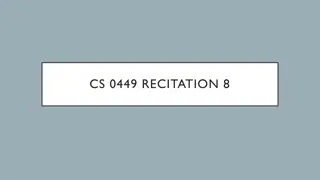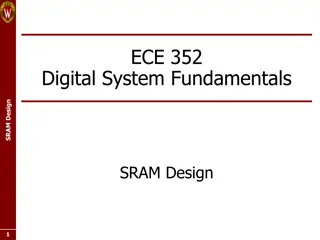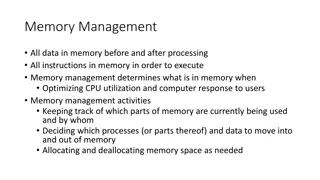Insights on Memory Performance Optimization and Bit Packing Techniques
Delve into the world of memory performance optimization techniques and bit packing strategies. Learn how to reduce memory waste, increase cache utilization, and minimize CPU costs. Discover the importance of alignment to avoid penalties and bad performances. Uncover a clever solution to a challenging scenario involving 1000 bottles, poison, servants, and prisoners, showcasing the effective use of binary numbering. The king's party is a success with a creative solution that saves lives. Explore the impact of memory speed, bandwidth, and latency on system performance in an insightful narrative filled with practical advice and examples.
Download Presentation

Please find below an Image/Link to download the presentation.
The content on the website is provided AS IS for your information and personal use only. It may not be sold, licensed, or shared on other websites without obtaining consent from the author.If you encounter any issues during the download, it is possible that the publisher has removed the file from their server.
You are allowed to download the files provided on this website for personal or commercial use, subject to the condition that they are used lawfully. All files are the property of their respective owners.
The content on the website is provided AS IS for your information and personal use only. It may not be sold, licensed, or shared on other websites without obtaining consent from the author.
E N D
Presentation Transcript
Bit packing like a mad man Amaury SECHET @deadalnix
Memory is slow About 300 cycles to hit memory Bandwidth still increasing Latency only marginally increasing
Memory is slow - Caching Add faster memory on CPU. Various size and speed Signal needs time to travel L1: 3-4 cycles, 32kb Instruction Data L2: 8-14 cycles, 256kb L3: tens of cycles, few Mb, often shared Cache line: 64 bytes
The king is throwing a party He has 1000 bottles in his cellar
The poison will kill anyone even in small doses. It takes several hours for someone to die from poisoning. The King has 1000 servants and 20 prisoners. He would like to avoid killing servants if possible, but killing prisoners is fine. An evil man poisoned a bottle with his secret recipe with 11 herbs and spices ! What should the king do ?
The answer The king can use 10 prisoners. Number each bottle in binary Each prisoner will drink from multiple bottles Prisoner n will drink bottle where the nth digit is 1 The prisoner ding will give the result in binary.
Bit packing Reduce memory waste Increase cache utilization Minimal CPU cost Not a replacement for better algorithms Instantiating less objects saves a lot of memory !
Alignment Ensure that load/store do not Cross cache line Cross pages boundaries Unaligned access: severe penalties Bad performances on some CPU, loss of atomicity Hardware is doing 2 accesses Hard error on others (SIGBUS or alike) Defined by ABI
Alignment Rule of thumb Integral types smaller than size_t T.sizeof Integral types bigger than size_t size_t.sizeof Compiler will decompose memory accesses Structs Max(alignment of each field) Add padding to respect alignment
Struct padding struct S { bool f1; uint f2; bool f3; } f1 pad f2 f3 pad 12 bytes, 6 wasted
Struct padding struct S { uint f2; bool f1; bool f3; } f2 f1 f3 pad 8 bytes, 2 wasted
Padding tips Start with fields with high alignment Know where pads are Enforce assumptions using static assert alignof sizeof Classes, like structs, but Implicit fields Vtable Monitor At least pointer size alignment
Information density How much actual information ? Bool 1 bit of information 8 bits of storage Object 45 bits of information 64 bits of storage Dump memory and zip it Aim for that size
Bit packing Trade memory consumption for CPU Usually a good deal Use one integral as storage Store several elements in that integral Use bitwise operations to manipulate elements std.bitmanip can help
Struct packing import std.bitmanip; struct S { mixin(bitfield!( uint, "f1", 30, bool, "f2", 1, bool, "f3", 1, )); } f1 f2 f3 4 bytes, 0 wasted f1 is now 30 bits instead of 32 bits Now about 1B max Fields aren t atomic anymore bitfield does all the magic
Bit packing intergals Data: enum ReadMask = (1 << S) 1; enum WriteMask = ReadMask << N; entry @property uint entry() { return (data >> N) & ReadMask; } 32 N 0 N + S @property void entry(uint val) in { assert(val & ReadMask == val); } body { data = (data & ~WriteMask) | ((val << N) & WriteMask); }
Bit packing bools enum Mask = 1 << N; Data: entry @property bool entry() { return (data & Mask) != 0; } 32 N 0 N + 1 Note: data ^ Mask will flip the bit It is sometime faster than to set it. @property entry(bool val) { if (val) { data = data | Mask; } else { data = data & ~Mask; } }
Bitfield layout 2 special spots Rightmost : mask only Leftmost : shift only Large elements require large mask Put them on the left most Bools always use masks Can be checked in leftmost with signed < 0 Don t put them in special spots unless very hot
Bitfield layout We want : One flag One 2 bits enum E A 29 bits integral What is the best layout ?
Bitfield layout enum E { E0, E1, E2, E3 } Codegen : struct S { import std.bitmanip; mixin(bitfield!( E, "e", 2, bool, "flag", 1, uint, "integral", 29, )); } e = cast(E) (data & 0x03); flag = (data & 0x04) != 0; integral = data >> 3;
Unused bits Sometime, the whole bitfield is not needed Create a nameless field uint, "", 29 Make it usable for out struct/subclasses uint, _derived", 29 Ideally make it private/protected Or use in private struct elements Need to implement the remaining fields manually Feature request: bitfield with explicit storage
Unused bits - example class Symbol : Node { Name name; Name mangle; class Field : Symbol { // ... import std.bitmanip; mixin(bitfields!( Step, "step", 2, Linkage, "linkage", 3, Visibility, "visibility", 3, InTemplate, "inTemplate", 1, bool, "hasThis", 1, bool, "hasContext", 1, bool, "isPoisoned", 1, bool, "isAbstract", 1, bool, "isProperty", 1, uint, "derived", 18, )); this(..., uint index, ... ) { // ... this.derived = index; // Always true for fields. this.hasThis = true; } @property index() const { // Only 262 143 fields possible ! return derived; } } }
Tagging pointers - @trusted Least significant bits are known to be 0 How many depends on alignment Log2(T.alignof) At least 3 bits on Objects (2 on 32 bits systems) Once again, std.bitmanip can help taggedPointer/taggedClassRef Checks alignment constraints at compiler time Misaligned pointers are not safe
Tagging pointers - @trusted enum Color { Black, Red } pointed struct Link(T) { import std.bitmanip; mixin(taggedPointer!( T*, "child", Color, "color", 1, )); } child struct Node(T) { Link!T left; Link!T right; } Actual pointer points at the object Tagged pointer point within the object GC knows about interior pointers
Tagging pointers - @system Allocate in the lower 32bits of address space Truncate pointer to 32 bits Limited to 4Gb Jemalloc can do that for you Used by HHVM for codegen On X86 most significant 16bits are zeros Hijack them ! Confuse the GC ! Try to not SEGFAULT
Intermission Germany loves D ! They even put stickers on their cars !
Lets use a context Useful for cold but often reused data For instance, identifiers in a compiler Usually don t care about the actual value Context store identifiers, provide a unique id 32 bits vs 128 bits Equality can be tested with an int compare Can be its own hash for hastable lookups Make the GC happy less pointers More noscan !
Lets use a context struct Name { private: uint id; this(uint id) { this.id = id; } public: string toString(const Context c) const { return c.names[id] } immutable(char)* toStringz(const Context c) const { auto s = toString(); assert(s.ptr[s.length] == '\0', "Expected a zero terminated string"); return s.ptr; } }
Lets use a context class Context { private: string[] names; uint[string] lookups; public: auto getName(const(char)[] str) { if (auto id = str in lookups) { return Name(*id); } // As we are cloning, make sure it is 0 terminated as to pass to C. import std.string; auto s = str.toStringz()[0 .. str.length]; auto id = lookups[s] = cast(uint) names.length; names ~= s; return Name(id); } }
Context prefill Useful to pin some id at compile time Can be used without lookup in the context Generated identifiers object.d Linkage/Version/Scope/Attribute
Context prefill enum Reserved = [ "__ctor", "__dtor", "__postblit", "__vtbl", ]; auto getNames() { import d.lexer; enum Prefill = [ // Linkages "C", "D", "C++", "Windows", "System", // Generated "init", "length", "max", "min", "ptr", "sizeof", "alignof", // Scope "exit", "success", "failure", // Defined in object "object", "size_t", "ptrdiff_t", "string", "Object", "TypeInfo", "ClassInfo", "Throwable", "Exception", "Error", // Attribute "property", "safe", "trusted", "system", "nogc", // ... ]; auto identifiers = [""]; foreach(k, _; getOperatorsMap()) { identifiers ~= k; } foreach(k, _; getKeywordsMap()) { identifiers ~= k; } return identifiers ~ Reserved ~ Prefill; } enum Names = getNames();
Context prefill template BuiltinName( string name, ) { private enum id = Lookups .get(name, uint.max); auto getLookups() { uint[string] lookups; foreach(uint i, id; Names) { lookups[id] = i; } static assert( id < uint.max, name ~ " is not a builtin name.", ); enum BuiltinName = Name(id); return lookups; } enum Lookups = getLookups(); }
More context ! Track locations in a compiler They are everywhere Register file in the context Allocate a range of value from N to N + sizeof(file) A position for each byte in the file ! Add a flag for mixin (D) / macros (C++) Register expansions in the context.
More context ! Use cases: Emit debug infos Error messages Perfs do not matter for errors Access pattern mostly predictable for debug Find file/line from location using One element cache Linear search (8 elements) Binary search
More context ! 2B 0 File 1 File 2 File 3 Empty Mixin 1 Mixin 3 Mixin 2 Empty -2B -1 Context store file boundaries and line position within files
More context ! A position is 31 bits number + a flag Up to 2Gb of source code + 2 Gb of macros/mixin A pair of positions is a location Used for tokens/expressions/symbols/statements Lexer only need to bump the position value for each token by the length of the token Strategy used by clang / SDC
Tagged reference Useful to encapsulate several reference types Can provide methods forwarding to elements Use reflection to do so Avoid vtable lookups/cascaded loads No common layout in the referenced object Number of elements limited by alignement Easy to get up to 8 on X64 LLVM s call/invoke
Tagged reference template TagFields(uint i, U...) { import std.conv; static if (U.length == 0) { enum TagFields = "\n\t" ~ T.stringof ~ " = ~ to!string(i) ~ ","; } else { enum S = U[0].stringof; static assert( (S[0] & 0x80) == 0, S ~ " must not start with an unicode.", ); static assert( U[0].sizeof <= size_t.sizeof, "Elements must be of pointer size or smaller.", ); mixin("enum Tag {" ~ TagFields!(0, U) ~ "\n}"); import std.traits; alias Tags = EnumMembers!Tag; import std.typetuple; alias TagTuple = TypeTuple!(uint, "tag", EnumSize!Tag); import std.ascii; enum Name = (S == "typeof(null)") ? "Undefined" : toUpper(S[0]) ~ S[1 .. $]; enum TagFields = "\n\t" ~ Name ~ " = " ~ to!string(i) ~ "," ~ TagFields!(i + 1, U[1 .. $]); } }
Tagged reference struct TaggedRef(U...) { private: import std.bitmanip; mixin(taggedPointer!( void*, "ptr", TagTuple)); template opDispatch(string s, T...) { auto opDispatch(A...)(A args) { final switch(tag) { foreach(T; Tags) { case T: auto r = get!T(); return mixin("r." ~ s)(args); } } } } public: auto get(Tag E)() in { assert(tag == E); } body { static union Helper { void* __ptr; U u; } } return Helper(ptr).u[E]; }
Value Type Polymorphism All subtypes fit under a given size budget A tag is used to differentiate them The whole thing is wrapped in an nice API Being able to hide atrocities behind a nice fa ade, that s the power of D Example: Representing D types
Value Type Polymorphism template SizeOfBitField(T...) { size_t computeEnumSize(E)() { size_t size = 0; static if (T.length < 2) { import std.traits; foreach (m; EnumMembers!E) { size_t ms = 0; while ((m >> ms) != 0) { ms++; } enum SizeOfBitField = 0; } else { enum SizeOfBitField = T[2] + SizeOfBitField!(T[3 .. $]); } import std.algorithm; size = max(size, ms); } } enum EnumSize(E) = computeEnumSize!E(); return size; }
Value Type Polymorphism struct TypeDescriptor(K, T...) { enum DataSize = ulong.sizeof * 8 - 3 - EnumSize!K - SizeOfBitField!T; import std.bitmanip; mixin(bitfields!( K, "kind", EnumSize!K, TypeQualifier, "qualifier", 3, ulong, "data", DataSize, T, )); static assert(TypeDescriptor.sizeof == ulong.sizeof); this(K k, TypeQualifier q, ulong d = 0) { kind = k; qualifier = q; data = d; } }
Value Type Polymorphism A type is a TypeDescriptor + an indirection field Data depend on the kind If it doesn t fit, use indirection field There are many type kind: Builtin Struct Class Alias Function Common API switch on kind to do the right thing
Value Type Polymorphism data Qualifier Kind Indirection 128 bits budget Indirection is used when The type need extra space (Function) The type need to refers to a symbol (Aggregate, Alias) Otherwise null Replaced the type class hierarchy advantageously Significant memory consumption reduction Significantly faster runtime (about 20%)
Value Type Polymorphism You can nest, effectively creating hierarcies For instance, Identifiable is A type An expression A symbol More packing !
Value Type Polymorphism Tag data Qualifier Kind Indirection/Expression/Symbol Tag is used to discriminate between Type Expression Symbol Tag is zeroed out to find the type Saved 70 Mb (!) of template bloat in SDC
Value Type Polymorphism import d.semantic.identifier; Identifiable i = ...; i.apply!(delegate Expression(identified) { alias T = typeof(identified); static if (is(T : Expression)) { return identified; } else { return getError( identified, location, t.name.toString(pass.context) ~ " isn't callable", ); } })();























